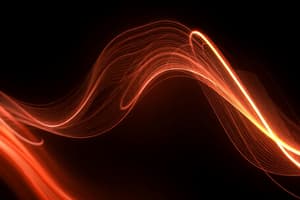Podcast
Questions and Answers
What type of surface reflects light in a diffuse manner?
What type of surface reflects light in a diffuse manner?
- Opaque surface
- Irregular, dull surface (correct)
- Smooth, shiny surface
- Transparent surface
What is the term for the line on a diagram that represents the direction and path of light?
What is the term for the line on a diagram that represents the direction and path of light?
- Light beam
- Light ray (correct)
- Incident ray
- Reflected ray
According to the Law of Reflection, what is the relationship between the angle of incidence and the angle of reflection?
According to the Law of Reflection, what is the relationship between the angle of incidence and the angle of reflection?
- Angle of incidence is equal to the angle of reflection (correct)
- Angle of incidence is three times the angle of reflection
- Angle of incidence is twice the angle of reflection
- Angle of incidence is half the angle of reflection
What is the term for a mirror that reflects light from the inner surface of a sphere?
What is the term for a mirror that reflects light from the inner surface of a sphere?
What is the point at which light rays parallel to the principal axis converge when reflected off a mirror?
What is the point at which light rays parallel to the principal axis converge when reflected off a mirror?
Which type of light is primarily used in medical imaging?
Which type of light is primarily used in medical imaging?
Which form of light is the most energy efficient and uses no filament?
Which form of light is the most energy efficient and uses no filament?
What type of electromagnetic wave is commonly used in remote controls?
What type of electromagnetic wave is commonly used in remote controls?
Which statement correctly describes 'Phosphorescence'?
Which statement correctly describes 'Phosphorescence'?
Which type of light is least likely to produce heat as it glows?
Which type of light is least likely to produce heat as it glows?
Flashcards are hidden until you start studying
Study Notes
Light and Electromagnetic Spectrum
- Light is packets of energy called photons
- Electromagnetic Spectrum: ranging from thinnest to widest wavelengths:
- Gamma Rays
- X-rays
- Ultraviolet
- Visible Light
- Infrared
- Radio Waves
- Electromagnetic Waves: Waves that have both electric and magnetic parts
- Uses of different wavelengths:
- Radio Waves: Cellphones
- Microwaves: Telecommunication
- Infrared Lights: Remote Controls
- Visible Light: Human Vision
- Ultraviolet Light: Increases skin cancer, Sterilization
- X-rays: Medical imaging
- Gamma Rays: Cancer treatment, product of nuclear decay
Forms of Light
- Luminous: Makes its own light
- Non-Luminous: Reflects light
- Forms of light:
- Incandescence: Producing light using high temperatures (most inefficient)
- Examples: Candle, stove element, incandescent light bulbs
- Electric Discharge: Electricity causes gas to glow
- Examples: Lightning, neon signs
- Phosphorescence: Watch dials that give off light due to absorbed energy
- Examples: Glow-in-the-dark items
- Fluorescence: Giving off visible light due to UV light absorption
- Examples: Highlight markers, CFLs
- Chemiluminescence: Light produced as a result of a chemical reaction (no heat produced)
- Examples: Glow sticks
- Bioluminescence: Chemiluminescence in an organism
- Examples: Firefly
- Triboluminescence: Production of light when certain crystals are crushed or rubbed together
- Examples: Sugar Cube
- LEDs: Result of an electric current flowing in one direction through a semiconductor
- Highly energy-efficient
- Incandescence: Producing light using high temperatures (most inefficient)
Light Rays and Geometric Optics
- Light Ray: A line on a diagram representing the direction and path that light is traveling
- Geometric Optics: The use of light rays to determine how light behaves when it strikes objects
- Incident Light: Light emitted from a source that strikes an object
- Material properties:
- Transparent: Transmits all or almost all incident light
- Translucent: Transmits some incident light, but absorbs or reflects the rest
- Opaque: Does not transmit any incident light
- Image: Reproduction of an object through the use of light
- Mirror: Any polished surface reflecting an image
- Reflection: The bouncing back of light from a surface
- Plane: Flat surface
- Incident Ray: The incoming ray that strikes a surface
- Reflected Ray: The ray that bounces off a reflecting surface
- Normal: The perpendicular line to a mirror surface
- Perpendicular: At right angles (90°)
- Angle of Incidence: The angle between the incident ray and the normal
- Angle of Reflection: The angle between the reflected ray and the normal
Law of Reflection
- Angle of incidence = Angle of reflection
- The incident ray, reflected ray, and normal lie all on the same plane
- Types of reflection:
- Specular Reflection: When light reflects off a smooth, shiny surface
- Examples: Plane mirror, very still lake
- Diffuse Reflection: When light reflects off an irregular, dull surface
- Examples: Light reflected off paper, crumpled up foil
- Specular Reflection: When light reflects off a smooth, shiny surface
Mirror Image Characteristics
- SALT:
- S: Size
- A: Attitude
- L: Location
- T: Type
Plane Mirror Methods
- 2 types of methods:
- Parallel Method
- Lab Method
Concave and Convex Mirrors
- Concave or converging mirrors: The reflection is from the inner surface of the sphere
- Examples: Makeup Mirror
- Convex or diverging mirrors: The reflection is from the outer surface of the sphere
- Examples: Side-view mirror of a vehicle
- Center of curvature (C): The center of the sphere whose surface has been used to make the mirror
- Principal Axis (PA): The line through the center of curvature to the midpoint of the mirror
- Vertex (V): The point where the principal axis meets the mirror
- Converge: To meet at a common point
- Diverge: To spread apart
- Focus (F): The point at which light rays parallel to the principal axis converge when they are reflected off a mirror
- Real Image: An image that can be seen on a screen as a result of light rays actually arriving at the image location
- Always inverted
- Virtual Image: An image formed by light coming from an apparent light source; light is not arriving at or coming from the actual image location
Studying That Suits You
Use AI to generate personalized quizzes and flashcards to suit your learning preferences.




